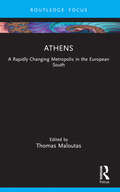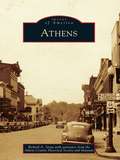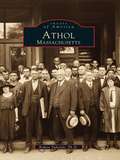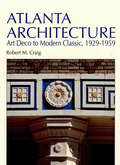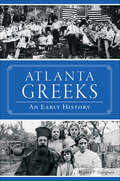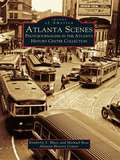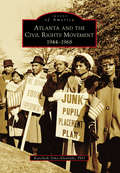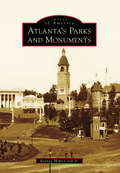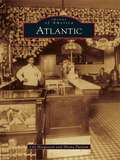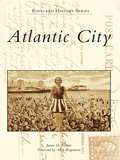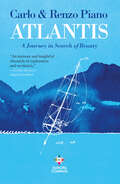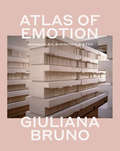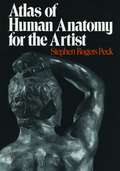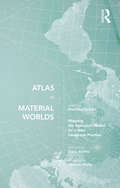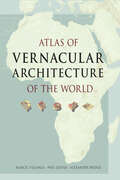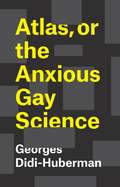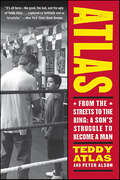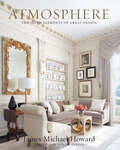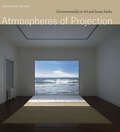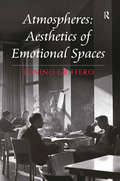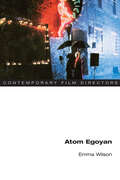- Table View
- List View
Athens: A Rapidly Changing Metropolis in the European South (Built Environment City Studies)
by Thomas MaloutasThis book looks at the current trends in Athens, the capital city of Greece, and focuses on the processes of globalization it has been undergoing during the last two decades. In this time the city has transformed from a low-key, petty bourgeois cohesive and rather isolated city in south-eastern Europe to an internationally visible metropolis, increasingly unequal and polarized.The book mainly deals with changes in the social structure and the ways that different groups are linked to the city’s built environment. The main issues discussed in the book include the economic identity and the position of Athens in the regional and global urban networks; the reproduction of class and ethnic boundaries and the uneven distribution of different social groups in urban space; the exploration of political processes related to the class vote, including the gender and demographic profile of the city’s electorate; the making of the built environment, the main trends in real estate and the ways they affect the housing market. Athens is not abundantly discussed in the urban studies literature, even though social and spatial changes have been remarkable. As such, this book provides a concise overview of the main socioeconomic and spatial changes in Athens during the last two decades and their significance beyond the case of Athens.This book will be of interest to researchers and students of the built environment, urban studies and urban sociology.
Athens: Excavations And Studies Conducted By The University Of Pennsylvania Museum And The British School At Athens (Images of America)
by Richard A. Straw Athens County Historical Society and MuseumIn the late 1700s, a group of men, largely from Massachusetts, came into the foothills of the Appalachian Mountains and settled a village in southeastern Ohio alongside the Hocking River. Calling it Athens to honor their belief in the primacy of education and culture in one's life, they set in motion a history that continues to inform and enliven life within this community today. Ohio University, the first public institution of higher learning in the Northwest Territory, was founded here in 1804. Athens has served as a business, service, cultural, and educational meeting place for over 200 years. As a result, Athens is a culturally diverse community of professors, plumbers, lawyers, craftsmen, restaurateurs, students, musicians, artists, and business owners, and it is heir to a historic past. This collection of fascinating photographs of people, places, homes, businesses, churches, and important events comes from the vast archives of the Athens County Historical Society and Museum. The images open the past and provide an informative glimpse into an earlier period of life in this unique community.
Athol, Massachusettes
by Robert TuholskiNestled among the hills of Massachusetts, 70 mileswest of Boston, Athol lies on the banks of the Millers River. First settled as "Pequoiag" in 1735 and incorporated as Athol in 1762, the evolution of Athol from a sparse, agrarian settlement to a bustling industrial community is a blueprint for the transformation of small-town America. This exciting collection presents a visual history of Athol at the dawn of the twentieth century. Athol, Massachusettsdocuments the changes as the town developed from an agrarian community into a thriving manufacturing center that harnessed Mill Brook and the Millers River to power the early mills. Through photographs, stereo cards, and postcards from a bygone era, this book provides a glimpse of what it was like to live and work in the Athol of long ago. The photographs from years gone by allow both young and old to meander down dirt roads along the stream, and become witness to their celebrations and their recreational retreats at the fairgrounds, Silver Lake, and Brookside Park.
Atividades para Crianças: Atividades gratuitas ou quase gratuitas que as crianças vão adorar!
by Frank Gathers Cassiane OgliariPara muitos pais, a frase mais assustadora que eles podem ouvir de seus filhos é: "Não tem nada para fazer". Manter os pequenos ocupados pode ser uma tarefa difícil para qualquer um, especialmente quando se está controlando os gastos. Isso se torna ainda mais desafiador quando você é uma pessoa ocupada que quer passar um tempo com os filhos. A infância passa tão rápido que normalmente piscamos os olhos e nossos filhos já cresceram e estão fazendo suas próprias coisas. Por isso aproveitar esses primeiros anos é tão importante. O que pode ser melhor do que ouvir seus filhos rindo prazerosamente enquanto se divertem com você? Isso é algo que todos nós queremos ouvir, mas, muitas vezes, não temos ideia de como fazer isso acontecer. Felizmente, há muitas ideias inteligentes que podem manter os pequenos entretidos por horas e muitas delas não vão pesar no seu orçamento. A questão é que nem todos os pais têm tempo para pensar em atividades novas e divertidas para seus filhos. Além disso, não podemos deixar nossos filhos na frente da televisão e deixar a tecnologia tomar conta; assim seria difícil as crianças terem uma infância adequada. Mas é cansativo tentar manter os filhos entretidos e, quando você acha que encontrou algo legal para fazer, eles já estão entediados novamente. Se suas ideias de atividades para fazer com seus filhos pequenos, com idade pré-escolar ou pré-adolescentes estão acabando, este livro em formato digital vai lhe dar a inspiração que você precisa. Neste livro, falamos sobre como preparar atividades ao ar livre fáceis e divertidas que são perfeitas para as crianças. Se o clima não permitir esse tipo de diversão ao ar livre, também temos atividades para ambientes internos que são perfeitas para os pequenos mais ativos! Mas o melhor é que além dessas atividades serem divertidas, elas também vão ensinar algo aos seus filhos, desde habilidades motoras finas até a importânci
Atlanta Architecture: Art Deco to Modern Classic, 1929-1959 (Atlanta Architecture)
by Robert M. CraigHaving been one the most successful boomtowns of the early twentieth century, Atlanta saw a transition from a town known for its Southern charm and history to a business hub. The result is a colorful mix of antebellum restorations and modern styles. Art Deco brought in cosmetic and theatrical elements to facades and interiors with examples like the Southern Bell Telephone Company Building, the Atlanta City Hall, and the W. W. Orr Doctors Building. Meanwhile, the Modern Classic was born out of the Public Works Administration projects of the Great Depression. Emphasizing a minimized classicism and trading artistic ornamentals for a more bureaucratic look, these buildings exemplify the style of the New Deal era as seen in the Federal Post Office, the Masonic Temple, and the public housing project of Techwood Homes. Craig also gives past-due credit to the designers themselves like Pringle & Smith, G. Lloyd Preacher, and A. Ten Eyck Brown, who deserve to be remembered among the century&’s noteworthy architects. From government offices to houses to movie theatres to retail stores, their history and features are covered in detail in this work, which adds to the resources available for historians, architects, and architectural aficionados.
Atlanta Greeks: An Early History (American Heritage Ser.)
by Stephen P. GeorgesonBy 1890, the first Greek immigrants to Atlanta had settled into an area still widely populated by Confederate veterans. In a city without the large immigrant presence common in the nation's major urban areas, the Greeks were initially received as undesirable visitors by the state's and city's leaders. While the Greek Orthodox Church of Atlanta endured financial hardship, it continued to aid funerals, hospitals and orphanages. These Greeks moved from the city's streets as fruit vendors into more established businesses. Christ Gyfteas's fruit stand at the corner of Broad and Marietta became the California Fruit Company. By 1911, 40 percent of Greeks were proprietors or partners in a variety of businesses like cafés, restaurants, soda fountains and groceries. Author Stephen Georgeson explores the Greek immigrants' experiences in their first three decades in Atlanta.
Atlanta Scenes: Photojournalism in the Atlanta History Center Collection
by Michael Rose Atlanta History Center Kimberly S. BlassAtlanta, the thriving capital of the New South, has a rich and fascinating history. In Atlanta Scenes, authors Kimberly S. Blass and Michael Rose draw from the works of some of the city's earliest and finest photojournalists--Francis Price, Marion Johnson, Bill Wilson, and Kenneth Rogers--to bring that history to life. Atlanta Scenes documents some of the city's noteworthy events, personalities, and landmarks, many of which will be readily identifiable. The images range from the everyday (baseball games at Ponce de Leon Ballpark, boys on bicycles, and Humane Society dog rescues) to the eventful (the Gone with the Wind premiere, the deadly Winecoff Hotel fire, and the infamous Leo Frank trial). Many scenes reflect the iconography of the Old South, while others provide insight into the harsh realities of twentieth-century life. In this volume, well-crafted, artistic images blend with on-the-spot action shots.
Atlanta and the Civil Rights Movement: 1944-1968 (Images of America)
by Phd Karcheik Sims-AlvaradoSince Reconstruction, African Americans have served as key protagonists in the rich and expansive narrative of American social protest. Their collective efforts challenged and redefined the meaning of freedom as a social contract in America. During the first half of the 20th century, a progressive group of black business, civic, and religious leaders from Atlanta, Georgia, challenged the status quo by employing a method of incremental gradualism to improve the social and political conditions existent within the city. By the mid-20th century, a younger generation of activists emerged, seeking a more direct and radical approach towards exercising their rights as full citizens. A culmination of the death of Emmett Till and the Brown decision fostered this paradigm shift by bringing attention to the safety and educational concerns specific to African American youth. Deploying direct-action tactics and invoking the language of civil and human rights, the energy and zest of this generation of activists pushed the modern civil rights movement into a new chapter where young men and women became the voice of social unrest.
Atlanta's Parks and Monuments
by Rodney Mims Cook Jr.Since the city's beginnings after the War of 1812, Atlanta has had a tradition of building with a regard for becoming a world-class metropolis. Before being burned by Union general William T. Sherman in 1864, the city's appearance was described by noted European architect and urban planner Leon Krier as "looking like London in the 18th century." Atlanta was surrounded by estates and plantations, and many of the plantation builders were influenced by Greek and Roman architecture. The argument of slavery to the contrary, builders saw Greek temples as symbols of democracy and, as a result, embraced Greek and Roman revival architecture as the dominant national style. Great monuments followed in this tradition to the letter in the capital of the South.
Atlantic
by Shiona Putnam Lila HoogeveenThe history of Atlantic is rooted in the story of unrelenting entrepreneur Franklin H. Whitney. His passion inspired a strong and enterprising breed of men who embraced his vision and settled in the lush hills and valleys of Cass County, Iowa, in the decade following the close of the Civil War. The railroad provided the impetus for rapid growth and prosperity, and Whitney's vision of a new city became a reality when his recommendation for a depot site was approved. Within six days, Whitney's agent, Thomas Miller, had built the first house from which Whitney ordered furrows plowed to the railroad grading. Atlantic was thus born. The town grew rapidly, and by 1869 civic and social organizations, churches, newspapers, banks, schools, and businesses were thriving. Atlantic also had its share of shady characters, outlaw gangs, and disasters. The photographs and stories in this book provide a glimpse into the lives of Atlantic's intrepid developers and the city they established in the valley of the Nishnabotna.
Atlantic Canadian Imprints, 1801-1820: A Bibliography
by Patricia Lockhart FlemingThe first comprehensive analytical bibliography of Atlantic Canadian imprints, this volume covers some 320 books, pamphlets, broadsides, government publications, and serials. Most have not been listed before in any bibliography or catalogue. They represent the holdings of more than thirty libraries and archives in the four Atlantic provinces, and in Ontario, Quebec, the United States, and England. Each entry follows the principles of descriptive bibliography and includes full collation, contents, record of paper, type, and binding, analysis of issue and state, and location of every copy examined. Historical notes deal with authorship, printing, publishing, distribution and sales, and with the content of important works and the relationship between items. Arrangement is by province, then by year of publication. The material catalogued encompasses a wide range of subjects. God and government are two of the most common, but there are many others: education, municipal organization, history, elections, transportation, agriculture, legal trials, and a number of societies—benevolent, national, religious, and masonic. There are also many almanacs, including one in German, several satires and addresses in verse, and a French abécédaire. Not surprisingly in a nineteenth-century Maritime bibliography, signal books and decisions about piracy abound. Six indexes provide access by author, title, genre, trades, place of publication, and language. Patricia Fleming’s work continues Marie Tremaine’s A Bibliography of Canadian Imprints, 1751–1800 and supplements that work with new and previously unlocated imprints. It adds an essential element to our understanding of print communication in Atlantic Canada.
Atlantic City
by James D. Ristine Allen PergamentAtlantic City was founded in 1854 and soon became a seaside resort surpassing all others, earning the nickname "Queen of Resorts." Chronicling the glory of the city from 1900 to 1930, these vintage postcards depict a time when visitors were eager to stroll on a local invention, the boardwalk; frolic on the beach; ride a rolling chair; and buy saltwater taffy. The annual Easter parade and Miss America Pageant became Atlantic City traditions.Amusement piers offered vaudeville, band concerts, thrill rides, diving horses, fishnet hauls, and more. Visitors stayed in grand hotels, among thelargest and finest in the world. Through more than 200 postcard images, the amazing spirit of this historic resort town is revealed.
Atlantis: A Journey in Search of Beauty
by Carlo Piano Renzo PianoThe renowned architect and his son sail from Genoa in search of Atlantis in this “intimate and insightful chronicle of exploration and revelation” (Kirkus Reviews, starred review).Renowned architect Renzo Piano—whose credits include the New Whitney Museum, the Pompidou Center,the New York Times Building, and others—and his son Carlo, a well-regarded journalist, set sail from Genoa one late summer day. They went looking for the lost city of Atlantis, which, according to legend, was built to harbor a perfect society. They sails across the Pacific, along the banks of the Thames and the Seine, reaching as far as Athens, San Francisco’s Golden Gate Park, and Osaka Bay.Embarking not only on a life-changing journey but also on series of conversations that are humorous, irreverent, erudite, and always entertaining, Renzo and Carlo seek out the perfect city. Along the way, they reflect on their own relationship, on fathers and sons, on the idea of travel itself, and perhaps most notably on architecture, space, and the secret life of forms.
Atlas of Emotion: Journeys in Art, Architecture, and Film
by Giuliana BrunoTraversing a varied and enchanting landscape with forays into the fields of geography, art, architecture, design, cartography and film, Giuliana Bruno’s Atlas of Emotion, winner of the 2004 Kraszna-Krausz award for "the world’s best book on the moving image", is a highly original endeavor to map a cultural history of spatio-visual arts. In an evocative montage of words and pictures she emphasizes that "sight" and "site" but also "motion" and "emotion" are irrevocably connected. In so doing, she touches on the art of Gerhard Richter and Annette Messagem: the film-making of Peter Greenaway and Michaelangelo Antonioni; the origins of the movie palace and its precursors, and on her own journeys to her native Naples. Visually luscious and daring in conception, Bruno opens new vistas and understandings at every turn.
Atlas of Human Anatomy for the Artist
by Stephen Rogers PeckStephen Rogers Peck's Atlas of Human Anatomy for the Artist remains unsurpassed as a manual for students. It includes sections on bones, muscles, surface anatomy, proportion, equilibrium, and locomotion. Other unique features are sections on the types of human physique, anatomy from birth to old age, an orientation on racial anatomy, and an analysis of facial expressions. The wealth of information offered by the Atlas ensures its place as a classic for the study of the human form.
Atlas of Material Worlds: Mapping the Agency of Matter for a New Landscape Practice
by Matthew SeibertAtlas of Material Worlds is a highly designed narrative atlas illustrating the agency of nonliving materials with unique, ubiquitous, and often hidden influence on our daily lives. Employing new materialism as a jumping-off point, it examines the increasingly blurry lines between the organic and inorganic, engaging the following questions: What roles do nonliving materials play? Might a closer examination of those roles reveal an undeniable agency we have long overlooked or disregarded? If so, does this material agency change our understanding of the social structures, ecologies, economies, cosmologies, technologies, and landscapes that surround us? And, perhaps most importantly, why does material agency matter? This is the story of the world’s driest nonpolar desert, pink flamingos, and cerulean blue lithium ponds; industrial shipping logistics, pudding-like jiggling substrates, and monuments of mud; galactic bodies, radioactive sheep, and the yellowcake of uranium. Put simply, this book dares readers to see the world anew, from material up. Atlas of Material Worlds offers this new relationship to our host environment in a time of mounting crises—accelerating climate change, ballooning socioeconomic inequality, and rising toxic nationalism—uniquely telling materialist stories for practitioners and students in landscape, architecture, and other built environment disciplines.
Atlas of Vernacular Architecture of the World
by Paul Oliver Marcel Vellinga Alexander BridgeThe first world atlas ever compiled on vernacular architecture, this comprehensive work illustrates the variety and ingenuity of the world’s vernacular building traditions from a multi-disciplinary, cross-cultural and comparative approach, using over sixty world and regional maps.Mapping such diverse aspects as materials and resources, technologies, structural systems, symbolism, forms and service systems on a cross-cultural and comparative basis, the Atlas of Vernacular Architecture of the World reveals the distribution, diversity and relationships of the world’s vernacular building traditions. Indicating geographical patterns, developments, lacunae and anomalies, it gives rise to new insights and understandings, stimulating new hypotheses, questions and research efforts.Augmenting the award-winning Encyclopedia of Vernacular Architecture of the World, the Atlas of Vernacular Architecture of the World constitutes a unique and unparalleled resource for anyone involved in the growing field of vernacular architecture studies, including architects, geographers, art historians, planners, folklorists, conservationists, builders, and anthropologists as well as being of use to all those working in the fields of heritage conservation, architecture, regeneration, energy efficient building, resources management, development and sustainability.
Atlas, or the Anxious Gay Science: How To Carry The World On One's Back?
by Georges Didi-Huberman Shane B. LillisAby Warburg’s Mnemosyne Atlas (1925–1929) is a prescient work of mixed media assemblage, made up of hundreds of images culled from antiquity to the Renaissance and arranged into startling juxtapositions. Warburg’s allusive atlas sought to illuminate the pains of his final years, after he had suffered a breakdown and been institutionalized. It continues to influence contemporary artists today, including Gerhard Richter and Mark Dion. In this illustrated exploration of Warburg and his great work, Georges Didi-Huberman leaps from Mnemosyne Atlas into a set of musings on the relation between suffering and knowledge in Western thought, and on the creative results of associative thinking. Deploying writing that delights in dramatic jump cuts reminiscent of Warburg’s idiosyncratic juxtapositions, and drawing on a set of sources that ranges from ancient Babylon to Walter Benjamin, Atlas, or the Anxious Gay Science is rich in Didi-Huberman’s trademark combination of elan and insight.
Atlas: From the Streets to the Ring: A Son's Struggle to Become a Man
by Peter Alson Teddy Atlas"Of all the people who have affected by my life and influence the choices I've made, none has been more important than my father."So begins the autobiography of legendary boxing trainer and commentator Teddy Atlas, who grew from the rebellious son of a doctor to a man who embraces, and lives by, his father's values and code.In this gritty, spellbinding tale, Atlas recounts his fascinating life -- as a juvenile delinquent on the streets of Staten Island; as a boxer and Golden Gloves champion under the tutelage of famed trainer Cus D'Amato; as a companion to the dangerous, unpredictable Sammy "the Bull" Gravano, up until the day Gravano turned rat and brought down crime boss John Gotti; and as a trainer of champions and contenders, among them fourteen-year-old Mike Tyson and heavyweight Michael Moorer, whom he led to the crown with a win over Evander Holyfield.Equally engrossing are Teddy Atlas's accounts of training dancer and choreographer Twyla Tharp for her successful comeback at age forty-two; his work with actor Willem Dafoe, preparing him for his role as a concentration camp boxer in the film Triumph of the Spirit; his journey to Poland to choreograph the film's boxing scenes; and his own performance in movies such as Play It to the Bone. In sharing his stories, Atlas reveals the philosophy by which he lives.Like Teddy Atlas -- inimitable, tough, honest, and wise -- this book inspires. It is about so much more than boxing. It is a story of overcoming hardships, of compassion for those in need, of tremendous personal integrity, and of personal and professional triumph.
Atmosphere, Architecture, Cinema: Thematic Reflections on Ambiance and Place
by Michael TawaAtmosphere, Cinema, Architecture: Thematic Reflections on Ambiance and Place explores cinema and architecture as ambient and affective settings or circumstances that can enable the emergence of atmosphere. This book is an interdisciplinary reading of cinematographic practice which develops useful implications for spatial composition in art and architectural design. The way a film is set up, directed, composed, framed, and technically constructed can provide parallels, analogies and metaphors for the spatial organisation of cities, landscapes and buildings. Likewise, the way a built setting is conceived and devised can inform approaches to framing and spatial organisation in cinematography. The book begins on a personal note with a series of recollected atmospheric experiences, leading to an investigation of ambiguity and consilient discrepancy as circumstantial conditions necessary for the production of atmosphere. The mood of melancholia is explored to show the pivotal role that ambiguity, discrepancy and irresolution play in its distinctive ambiance. Atmosphere is then defined as an emergent condition arising between an ambient, affective circumstance and a mooded human being. The book then moves to analyse the inherent conditions in the setup of filmic and architectural settings that render them atmospheric. Reference is made to the cinema of Bresson, Resnais, Lynch, Tarr, Malik and Campion, and to Romanesque tympanae, the architectonic scenography of Franz Kafka’s novel The Castle and the work of Spanish architects Flores Prats. The concluding section, Anatomy of Atmosphere, is a lexicon of concepts, themes and tactics around atmosphere that might usefully inform creative practice.
Atmosphere: The Seven Elements of Great Design
by James Michael HowardA sought-after interior designer shares his principles for transforming four walls, a floor, and a ceiling into stunning poetry in space. Jim Howard creates luxe yet comfortable homes for sophisticated clients around the country. His design work is known for the sort of evocative atmosphere that characterizes the world&’s great spaces. &“Atmosphere&” is the magic of a place, the embodiment of all its power to capture your attention and embrace you—some might call it the &“wow factor.&” But even as it excites, atmosphere also soothes, offering an overall feeling of well-being and calm. Howard wrote this book to convey all he has learned about crafting atmosphere at home, wherever that home may be, whatever aesthetic it might have. Doing so isn&’t just a matter of rules or formulas; it is a science as much as an art, which Jim shares in a dozen captivating chapters.
Atmospheres of Projection: Environmentality in Art and Screen Media
by Giuliana BrunoBringing together cultural history, visual studies, and media archaeology, Bruno considers the interrelations of projection, atmosphere, and environment. Projection has long been transforming space, from shadow plays to camera obscuras and magic lantern shows. Our fascination with projection is alive on the walls of museums and galleries and woven into our daily lives. Giuliana Bruno explores the histories of projection and atmosphere in visual culture and their continued importance to contemporary artists who are reinventing the projective imagination with atmospheric thinking and the use of elemental media. To explain our fascination with projection and atmosphere, Bruno traverses psychoanalysis, environmental philosophy, architecture, the history of science, visual art, and moving image culture to see how projective mechanisms and their environments have developed over time. She reveals how atmosphere is formed and mediated, how it can change, and what projection can do to modify a site. In so doing, she gives new life to the alchemic possibilities of transformative projective atmospheres. Showing how their “environmentality” produces sites of exchange and relationality, this book binds art to the ecology of atmosphere.
Atmospheres of Projection: Environmentality in Art and Screen Media
by Giuliana BrunoBringing together cultural history, visual studies, and media archaeology, Bruno considers the interrelations of projection, atmosphere, and environment. Projection has long been transforming space, from shadow plays to camera obscuras and magic lantern shows. Our fascination with projection is alive on the walls of museums and galleries and woven into our daily lives. Giuliana Bruno explores the histories of projection and atmosphere in visual culture and their continued importance to contemporary artists who are reinventing the projective imagination with atmospheric thinking and the use of elemental media. To explain our fascination with projection and atmosphere, Bruno traverses psychoanalysis, environmental philosophy, architecture, the history of science, visual art, and moving image culture to see how projective mechanisms and their environments have developed over time. She reveals how atmosphere is formed and mediated, how it can change, and what projection can do to modify a site. In so doing, she gives new life to the alchemic possibilities of transformative projective atmospheres. Showing how their “environmentality” produces sites of exchange and relationality, this book binds art to the ecology of atmosphere.
Atmospheres: Aesthetics Of Emotional Spaces
by Tonino GrifferoOriginally published in Italian in 2010, this book is the first to address the theory of atmospheres in a thorough and systematic way. It examines the role of atmospheres in daily life, and defines their main characteristics. Outlining the typical phenomenological situations in which we experience atmospheres, it assesses their impact on contemporary aesthetics. It puts forward a philosophical approach which systematises a constellation of affects and climates, finds patterns in the emotional tones of different spaces (affordances) and assesses their impact on the felt body. It also critically discusses the spatial turn invoked by several of the social sciences, and argues that there is a need for a non-psychologistic rethinking of the philosophy of emotions. It provides a history of the term 'atmosphere' and of the concepts anticipating its meaning (genius loci, aura, Stimmung, numinous, emotional design and ambiance), and examines the main ontological characteristics of atmospheres and their principal phenomenological characteristics. It concludes by showing how atmospheres affect our emotions, our bodies' reactions, our state of mind and, as a result, our behaviour and judgments. Griffero assesses how atmospheres are more effective than we have been rationally willing to admit, and to what extent traditional aesthetics, unilaterally oriented towards art, has underestimated this truth.
Atom Egoyan (Contemporary Film Directors)
by Emma WilsonThe films of Atom Egoyan immerse the viewer in a world of lush sensuality, melancholia, and brooding obsession. From his earliest films Next of Kin and Family Viewing, to his coruscating Exotica and recent projects such as Where the Truth Lies, Egoyan has paid infinite attention to narrative intricacy and psychological complexity. Traumatic loss and its management through ritual return as themes in his films as he explores personal scenarios of mourning and broader issues of genocide, exile, and postmemory, in particular in relation to his own Armenian heritage. In this study, Emma Wilson closely analyzes the range of Egoyan's films and their visual textures, emotional control, and perverse beauty. Offering a full-scale chronological overview of Egoyan's work on films up to and including Where the Truth Lies, Wilson shows the persistence and development of certain structures and themes in Egoyan's cinema: questions of exile and nostalgia, trauma and healing, the family and sexuality. While drawing on ideas about intercultural cinema, Wilson also sets Egoyan's films in the context of contemporary Canadian cinema and European art-house cinema. Egoyan's own comments on his films thread throughout Wilson's analyses, and the book features a recent interview with the director.
